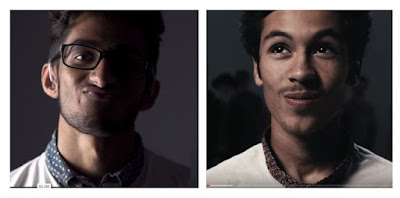The film opening itself has a strong focus on the representation of young men within the age group of 16-24. This is because the film opening is largely focused on our antagonist who is of this gender and age group. We chose to represent this particular social group as powerful and in control as not only is it convention, we also felt it would empower men and therefore increase male appeal - particularly amongst the 16-24 age group. We created these representations through costume, acting and camera.
A large reason why we chose this social group to primarily represent in our film opening is due to convention. From my research it was clear that males are very strongly represented in the film industry, and therefore it would be conventional to have a male lead thus allowing audiences to identify with and engage with our film more easily.
 |
| The strong male representation in the film industry |
There were 3 main ways by which we represented our character as powerful and in control:
1) Costume:
As you can see in this picture our antagonist is simply wearing a hoodie and tracksuit bottoms. First of all, this makes him instantly identifiable to the audience as being a part of the 16-24 age bracket as this type of clothing is very common amongst this age group. In this way our character becomes more relatable which increases appeal and better engages the audience.
We made sure that our antagonist took his hood off. This makes him seem more comfortable within this situation, and that way he appears more confident of his own safety as he's not trying to hide himself. This shows him to be in control of the situation as clearly there is no immediate risk to him.
Building on the previous point, the fact that he's wearing tracksuit bottoms and a hoodie shows how comfortable he is, as these clothes are associated with lazing around, and therefore once again shows him to be in control.
2) Acting:
Throughout our film opening our antagonist doesn't seem to walk with much urgency, rather he walks at quite a normal, comfortable pace. This shows there is no danger to him currently as he is in control of the situation.
Additionally, when the antagonist is sitting, he sits in a comfortable and laid-back manner. Normally, in such a tense situation you would expect him to be on the edge of his seat, and so this shows his power and how he's in control.
3) Camera:
Throughout the film opening the camera seemingly follows our antagonist. Through the continuity editing we have also placed the audience in the action in the beginning. Therefore, it creates the illusion that the audience are following the antagonist through the house, this means the antagonist sees and knows everything before the audience thus putting him in a position of power.
Sherlock:
Both Sherlock and our film opening share similar antagonists. Moriarty in Sherlock is often seen to be in power and in control of the situation.
 |
| Moriarty from Sherlock |
As you can see in this shot, despite being held at gunpoint by Sherlock, Moriarty stays calm instead of panicking as you would expect. In this situation, you would expect the power dynamic to be in Sherlock's favour, yet from Moriarty's mood and expression it almost seems as if he still has the power and is in control. This is the behaviour of a well constructed antagonist and so we were inspired by it when making our character choices.
Additionally, we used the news team as a means of representing the 20-30 age group as working, young professionals. This is obvious as they play arguably the biggest roles in a news team which is news anchor and news reporter and so this would require a very high level of professionalism. We also had the roles played by both gender and used two people of different ethnicities as we felt this accurately reflected the social make-up of London and so it was the sort of diversity the audience would have expected.

As you can see our characters are clearly portrayed as young professionals and display ethnic diversity.
This news reporter from Quarantine was a big influence for having a female news reporter.



























